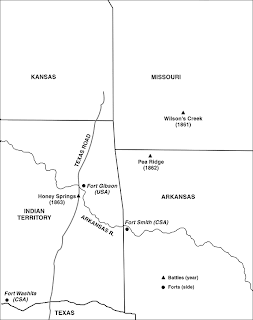 |
| Dunlap House at Ocmulgee National Monument |
149 years ago today, Union and Confederate forces battled at the Battle of Dunlap Hill (also called Dunlap's Farm) at Macon, Georgia.
It was at this battle that Stoneman's Raid, a Union military expedition designed to free the prisoners of war at Andersonville, Georgia, began to unravel. Gen. George H. Stoneman, whose name has been perpetuated in modern times in the lyrics of the song "The Night They Drove Old Dixie Down" would be captured two days later in a disaster that would rank as one of the worst cavalry defeats of the entire Civil War.
 |
Gen. George H. Stoneman
Library of Congress |
Stoneman's plan to raid the prisoner of war camps at Camp Oglethorpe in Macon and Camp Sumter at Andersonville was part of the Atlanta Campaign, which raged in the summer of 1864. The Union army of Gen. William Tecumseh Sherman and the Confederate army of Gen. John Bell Hood were engaged in brutal fighting that would determine the fate of Atlanta and in many ways that of the Confederacy itself. One week after Hood had struck out against Sherman at the Battle of Atlanta, Gen. Stoneman approached Sherman with an idea that might shatter Confederate hopes of holding Atlanta.
With 2,104 men and two pieces of artillery, Stoneman proposed that he make a lightning raid south from Atlanta, break the railroad to Macon by which the Confederates were bringing in supplies, and then liberate the thousands of Union prisoners of war being held at Macon and Andersonville.
 |
| Confederate Earthworks at Dunlap Farm |
Sherman was wary of the idea, but ultimately decided that it was worth a try. He warned Stoneman, however, to focus first on breaking the railroad and not to try to reach the prison camps unless conditions on the ground looked very favorable. Stoneman rode out from Decatur on July 27, 1864, however, which his sights set clearly on Macon and Andersonville.
The Union raiders struck the railroad just as Sherman had ordered, but in the process gave Georgians a preview of the terror they would experience later that year during the March to the Sea. Homes, villages and farms were looted, livestock taken or killed, barns destroyed and civilians terrorized.
 |
Gen. Howell Cobb
Library of Congress |
Confederate cavalry fell back ahead of Stoneman's rampaging raiders, skirmishing as they did so. The skirmishing intensified as the head of the Union column approached Macon, with the Confederates showing strong indications that they were preparing to stiffen their spines and give Stoneman a battle as he approached the important city. The Union general, however, overestimated his own capabilities and severely underestimated those of his waiting opponent, Maj. Gen. Howell Cobb.
Despite signs of stiffening Confederate resistances, Stoneman pushed into the outskirts of Macon on the morning of July 30, 1864, 149 years ago today.
Far from carrying out the lightning raid he had proposed to Sherman, the Union general had given his men too much time to loot and pillage as they came south. In doing so, he gave General Cobb's Confederates too much time to prepare for the coming battle.
 |
| Restored Blockhouse at Fort Hawkins |
With the 5th Georgia Reserves, units fro the Georgia State Militia, volunteers and every other company he could find, Cobb prepared to defend Macon. Field artillery was placed on the grounds of old Fort Hawkins across the Ocmulgee River from downtown Macon. Only the blockhouse of the old War of 1812 fort still stood, but Confederate officers used it as a lookout from which they could direct the fire of their guns.
The Confederate infantry took up position in trenches and field fortifications that guarded the approaches to Macon via the old Clinton Road. Much of the battle was fought on land belonging to the Dunlap family and soldiers battled each other on the grounds of the Dunlap House and virtually in the shadow of the massive prehistoric Indian mounds of the Macon Plateau.
The site of much of the fighting is preserved today as part of Ocmulgee National Monument in Macon, which focuses primarily on the massive and amazing prehistoric site. A trail and interpretive signage, however, tell visitors about the Battle of Dunlap Hill and provide access to the yards of the historic Dunlap House, which still stands, as well as the Confederate earthworks that can still be seen in its yard.
Nearby Fort Hawkins is now an archaeological park and although the blockhouse located there during the battle no longer stands, a recreation can be seen along with interpretive signage and other exhibits.
 |
| Cannonball House in Macon |
In Macon itself, the famed "Cannonball House" is now a museum. It was struck by a cannonball fired by Union troops as they shelled civilian areas of the city during the battle.
The Georgia reserves and militia fought much harder than Stoneman expected and it soon became clear that he would not take Macon and his dream of becoming the liberator of Andersonville would not be realized. He ordered a withdrawal back from Macon, leaving the battlefield of Dunlap Hill in the hands of the Confederates.
The ordeal of the Union general and his 2,000 cavalrymen, however, was far from over. He had unleashed a hornet's nest on himself that would come down with full fury two days later at the Battle of Sunshine Church. I'll post more about that on Wednesday.
To learn more about the Battle of Dunlap Hill, please visit
www.exploresouthernhistory.com/dunlaphill.



















































